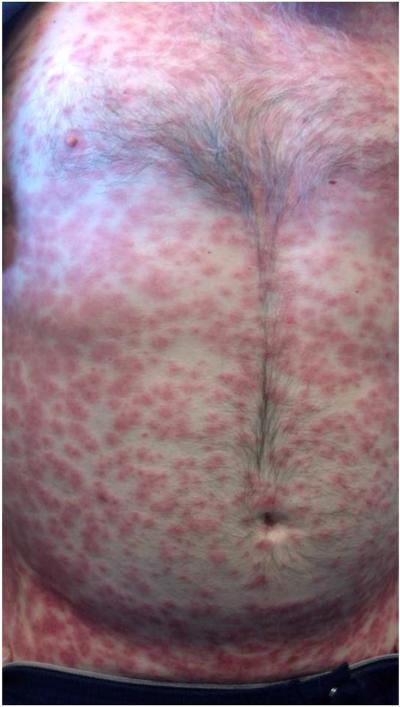A 67-year-old man with chronic lymphocytic leukemia (CLL) and deletion of chromosome 17p presented to clinic for evaluation of leukocytosis (total white blood cell count 149,000/mm3, absolute lymphocyte count 144,000/mm3) associated with fatigue, drenching night sweats, and recurrent viral infections. He had been treated previously with a combination of rituximab, cyclophosphamide, vincristine, and prednisone as well as rituximab and bendamustine (B-R), with the most recent therapy 3 years prior to his clinic visit. He had previously declined referral for hematopoietic stem cell evaluation. He was started on ibrutinib 420 mg PO daily in combination with allopurinol 300 mg PO daily for prophylaxis against tumor lysis syndrome.
Two weeks after beginning therapy, he developed a painless, non-pruritic, rash that began on his wrists and then spread to his entire body (Image 1). The rash was characterized by a diffuse distribution of bright red edematous papules, ranging from 0.5 to 1 cm in diameter, with sparing of his palms and soles. He was evaluated in the Emergency Department and both allopurinol and ibrutinib were held. His absolute eosinophil count at the time was within the normal range (100/mm3). Within several days his rash had completely resolved, and given consideration for allopurinol as the etiology of his rash, he was restarted on dose-reduced ibrutinib (140 mg PO daily) without allopurinol. After a single dose, he developed recrudescence of his full-body rash and ibrutinib was once again discontinued. The rash again resolved within several days of discontinuing ibrutinib.
Image 1.
Painless, non-pruritic edematous papules on the trunk of a patient who developed an ibrutinib-related rash. Lesions began on the wrists and arms and subsequently generalized to the entire body.
Ibrutinib (Imbruvica, Pharmacyclics/Janssen Biotech), an oral Bruton's tyrosine kinase inhibitor, was approved in February 2014 by the Federal Drug Administration for the treatment of CLL patients who have received at least one prior therapy. Ibrutinib is generally very well-tolerated, with few Grade 3 or higher adverse events [1–3]. In published studies, rash occurs at a frequency of 15–27%, although no identifying characteristics have been reported. In this case, clinical features distinguishing the rash from a classic allopurinol-mediated rash included its presentation with edematous papules (versus the morbilliform rash commonly associated with allopurinol) and its peripheral-to-central pattern of spread.
Footnotes
Conflict of interest: Nothing to report.
References
- 1.Byrd JC, Furman RR, Coutre SE, et al. Targeting BTK with ibrutinib in relapsed chronic lymphocytic leukemia. NEJM. 2013;369:32–42. doi: 10.1056/NEJMoa1215637. [DOI] [PMC free article] [PubMed] [Google Scholar]
- 2.O'Brien S, Furman RR, Coutre SE, et al. Ibrutinib as initial therapy for elderly patients with chronic lymphocytic leukaemia or small lymphocytic lymphoma: an open-label, multi-center, phase 1b/2 trial. Lancet Oncol. 2014;15:48–58. doi: 10.1016/S1470-2045(13)70513-8. [DOI] [PMC free article] [PubMed] [Google Scholar]
- 3.Wang ML, Rule S, Martin P, et al. Targeting BTK with ibrutinib in relapsed or refractory mantle-cell lymphoma. NEJM. 2013;369:507–516. doi: 10.1056/NEJMoa1306220. [DOI] [PMC free article] [PubMed] [Google Scholar]



